|

|
Background on Sustainable Livelihoods Approach:
The sustainable livelihoods approach is a tool for understanding how household livelihood systems interact with the outside environment – both the natural environment and the policy and institutional context. The livelihoods approach is concerned first and foremost with people. It seeks to gain an accurate and realistic understanding of people’s strengths (assets or capital endowments) and how they endeavour to convert these into positive livelihood outcomes. The approach is founded on a belief that people require a range of assets to achieve positive livelihood outcomes; no single category of assets on its own is sufficient to yield all the many and varied livelihood outcomes that people seek. This is particularly true for poor people whose access to any given category of assets tends to be very limited. As a result they have to seek ways of nurturing and combining what assets they do have in innovative ways to ensure survival.
The sustainable livelihoods approach (SLA) idea was first introduced by the Brundtland Commission on Environment and Development as a way of linking socioeconomic and ecological considerations in a cohesive, policy-relevant structure. In a classic 1992 paper “Sustainable Rural Livelihoods: Practical concepts for the 21st Century”, Robert Chambers and Gordon Conway defined the core elements of what comprises a “livelihood”.
The approach was further developed by researchers at the Institute for Development Studies (IDS) at the University of Sussex, Brighton, UK. It was introduced into the UK’s Department for International Development (DFID) policy in the late 1990s, and widely used by many organizations during the early part of the millennium. Although the approach has since been overtaken by other approaches (e.g. ‘human rights’, ‘governance’ approaches) it is still very relevant today.
The SLA explores how people meet basic needs and build up assets, and importantly, how those assets are used in two ways: as ‘the engine’ for their livelihood strategies; and as a ‘buffer’ for reducing vulnerability to shocks and stresses. SLA provides a model for navigating the “reality” that people face every day and adding to this a different range of rehabilitation and development interventions. Most importantly, it has provided new insights into the livelihoods of the poor and emphasised the importance of working alongside poor people and supporting them in reducing poverty.
Figure 1 depicts the various elements that make up the sustainable livelihoods framework, as originally developed by IDS and DFID:
- The left hand section of the figure shows how the vulnerability context impacts on the livelihood assets of rural people – denoted by a pentagon.
- Livelihood assets are also influenced by outside policies, institutions and processes.
- Livelihood strategies of different households are shaped by their asset base and the policy and institutional context in which they live.
- Livelihood outcomes of different types of households are influenced by the vulnerability context – people’s exposure to unexpected shocks – and their ability to withstand the shocks, which depends on their asset base.
Figure 1: The asset pentagon lies at the core of the sustainable livelihoods approach, ‘within’ the vulnerability context
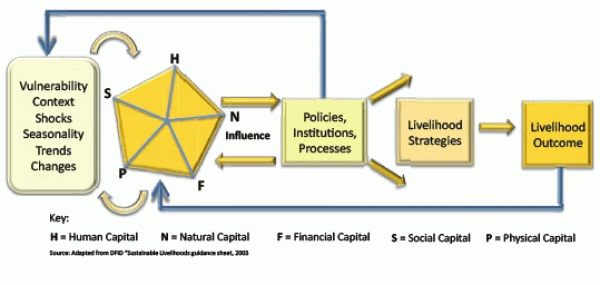
|
|

|
Sustainable Livelihood Assets:
Assets are the important part of any sustainable livelihood. By building assets, individuals and households develop their capacity to cope with the challenges they encounter and to meet their needs on a sustained basis. The approach pays particular attention to the variety of assets that contribute to making a sustainable livelihood and to ways in which they are interdependent.
Assets context: There are different assets that people have; the amounts available to them vary. The following are some types of livelihood assets (it is not an exhaustive list):
- Human assets: would include household members, active labour, education, knowledge skills (including technical and interpersonal); knowledge; ability; employability and earning power; good health; leadership. In a wider definition, it can also include motivation; self-esteem; self-confidence; self-perception; emotional well-being; assertiveness; spirituality.
- Physical assets: livestock, equipment, vehicles, houses, implements, and other physical (production) assets.
- Natural assets: would include access to land, forests, water, grazing, fishing, wild products and biodiversity.
- Financial capital: can include income from productive activity (employment/self-employment); available finances/savings; regular inflows of money from government transfers, family, gifts or in kind; access to credit; savings/debt, gold/jewelry, etc.
- Social assets: would include kin networks; group membership; socio-political voice and influence; cooperation; networks, inter-connectedness; family support; friendships; relationships of trust/exchanges; partnership and collaboration; political participation.
Vulnerability context: The vulnerability context refers to unpredictable events that can undermine livelihoods and cause households to fall into poverty. Some of these factors are fast acting (such as earthquakes) and others are slower acting (such as soil erosion), but both can undermine livelihoods. Factors that create and perpetuate vulnerability and poverty can be seen at two levels: at individual level and their circumstances, and the wider context. Therefore, there is a need to also seek changes at the organizational, community and policy levels in addition to building the assets of individuals and households.
Creating and building assets as part of sustainable livelihoods:
The territorial approach for sustainable livelihoods bridges the gap between the existing assets communities have at their disposal (left pentagon in figure 2) and the outcomes and impact that the improvements to these assets will have on the communities (right pentagon in figure 2). This requires both practical interventions (e. g. rehabilitation through cash-for-work) as well as strategic interventions (e.g. policy advice and support).
Figure 2: Linking asset building and backbone concept in order to improve sustainable livelihoods
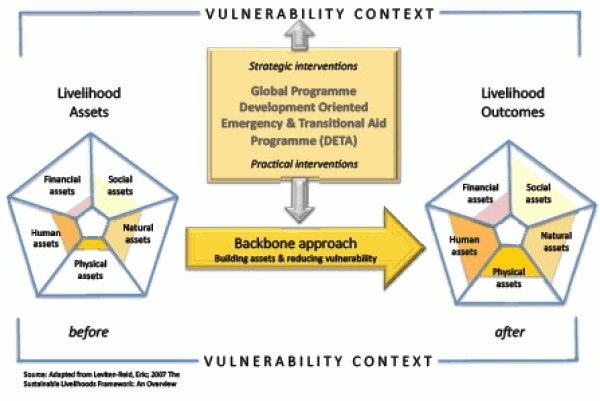
|
 |
Underlying principles:
- Defined impacts: Four intended impacts lie at the centre of the approach: i) Agricultural and non-agricultural production and household incomes increased; ii) Communities and sub-national local governments (e.g. districts, provinces) are better able to plan, implement and monitor development projects more transparently and efficiently; iii) Beneficiaries access to and ability to make better use of better public and private services improved; iv) Beneficiaries ability to manage conflicts peacefully improved.
- Pragmatic asset creating outcomes: The approach concentrates on the following four main outcomes (compare figure 3): i) organisational systems and structures at community, inter-village, district and provincial levels operational and gradually interlinked; ii) effectiveness of state and private (agricultural) business service providers improved for production and productivity increases as well as increases in income generation; iii) social and productive infrastructure rehabilitated and built; iv) conflict sensitivity amongst communities improved, peaceful conflict management approaches introduced and support peace opportunities undertaken.
- Territorial concentration: In view of resource limits and absorption capacity limits, it is neither possible nor realistic to cover large geographic areas. It is almost inevitable that some for of territorial concentration is required. The concentration would be along the so-called developmental backbone. By investing in either more “hardware” projects (roads, irrigation systems, etc) or in “software” (i.e. natural resource management, income generating, employment generating and capacity development) activities the intention is to provide the communities with a certain continuity of investments over time. The territorial intervention along the backbone is a time-bound intervention, usually lasting 2-3 years.
- Sequencing: The time-bound intervention along the backbone needs to be followed up by further (sectoral) investments, especially capacity building. This would then allow for the consolidation and expansion of the initial impact along the backbone project.
- Indicators to guide in area selection for both interventions and also for exit: Indicators need to be developed in order to be able to provide the basis for selecting intervention areas. The same indicators should then provide the basis for exiting the area after a defined period of intervention (e.g. 2-3 years). Possible criteria that could be used include: Accessibility / remoteness of districts; Vulnerability, as measured in kcal/capita, Level of coverage / concentration of donor or implementing organisations, Population densities, Level of security in the area, Level of basic service provision (i.e. health, education, water facilities, etc)
- Holistic and integrated approach. The time-bound territorial concentration focusing on the backbone approach will be complemented by investments in other strategic activities in the area outside of the backbones (i.e. other districts or areas in a province) pending the arrival of the holistic terriorial approach.
Although the following process description is sequential, in reality the processes often take place in parallel. It is therefore important to bear in mind when implementing all the following processes that some can be undertaken simultaneously.
Process 1: Territorial concentration of project / programme intervention activities:
At a political level, governments are expected to provide equal services to all its citizens throughout the country. In reality this is rarely possible. National governments often do not have the necessary financial and personnel resources to achieve this, much less the donor organisations. Even when all resources are combined, these are almost always insufficient to achieve a high level of service coverage. Invariably, a need to focus support is required, especially in a post conflict / post disaster period.
The approach concentrates its interventions, by definition, in selected areas along selected backbones. The selection process for a backbone will be in accordance with priorities that have been established for the areas (e.g. in district and provincial development plans) and within the ambit of being able to make a visible impact on the livelihoods of the communities living in and around the backbone project. „Backbones” can be added both within the selected geographic areas or in new areas in accordance with the availability of resources (especially funds).
Process 2: Thematic concentration:
The territorial approach proposes a thematic concentration on the rehabilitation and construction of production infrastructure (e.g. agriculture, roads, irrigation systems, water supply, health centres, schools, etc). The objective being that communities should achieve food-security as quickly as possible (either by having access to the food or it being available through improved production). To ensure sustainability, the backbone concept also includes a strong element of capacity development. Other development “themes” need to be covered by other developmental interventions as part of the continuum process of linking relief, rehabilitation and development in a post-conflict /post-disaster period.
Process 3: Development Funds:
An important key instrument for the backbone approach is the implementation of development funds. Development funds have proved to be innovative approaches for promoting both good governance and / or decentralisation. The objective of the funds is to provide untied funds for local self-governances (e.g. district or provincial councils and administrations). Untied means that the funds are not linked to a specific developmental sector (i.e. agriculture, health, etc). The backbone approach advocates for two funds at the sub-national level:
- Provincial or regional development fund (PDF), and
- District or local council development fund (DDF)
Each fund has a different function. The district development fund is the central fund out of which the backbone project and support projects are financed. The provincial development fund provides resources for inter-district development activities (i.e. roads between districts, provincial services, etc) as well as providing resources in those districts that do not benefit from a district development fund. The way in which the two funds interact has been depicted in figure 3.
Ideally the funds would be a pre-cursor to the central government allocating non-sector bound funds to the sub-national level (i.e. block grants or funds). If the national government does not intend to do this, then the establishment of the funds can be a temporary instrument to introduce and improve overall levels of governance.
Separating out the exact roles and functions of the different funds is very important. For example, a district development fund could be used to support development measures being undertaken within a district. The management of such a fund should be at the district level. A provincial fund would focus on funding activities that are of importance for the province, for example, projects that go beyond a district level, could be inter-district projects. Funds could also be allocated initially to the higher order fund (e.g. the provincial fund). The provincial level would then prioritise and bulk allocate funds between the different districts (but not the allocation for actual projects).
Figure 3: Territorial areas selected for backbones and role of provincial and district funds
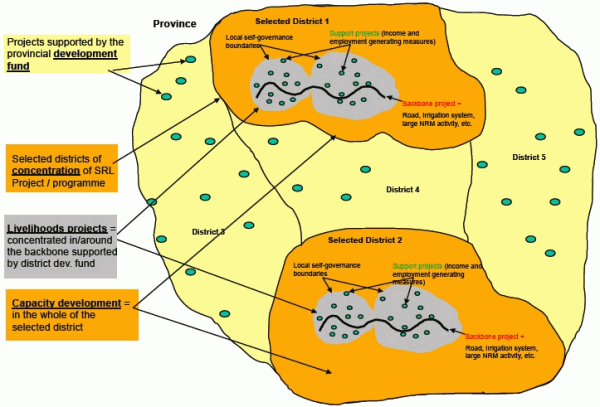
Process 4: Elaborate and agree upon an organisational structure and governance system for the two funds:
Both funds require the elaboration of governance and management structures, including a set of rules and procedures. This can be in form of a manual or handbook. The key to the whole manual / handbook is the selection process that will be designed to select intervention methods. The manual or handbook will also contain the procedure and set of criteria by which a council or committee would assess projects proposed by communities to be supported by the funds (compare Methodfinder method on “Development Funds”).
Process 5: Community mobilisation:
Community mobilisation is a process of engaging communities through participatory methodologies with the objective of giving them the confidence to take responsibility for identifying potentials and solving problems that hinder them from tapping existing potentials. It is important to move away from only talking about “problems” towards a discussion about existing or latent potentials. This adds a positive dimension to development (behind every problem there is a potential). Community mobilisation empowers women and men to organize their own democratically self-governing groups or community organizations, which enable them to initiate and control their own personal and communal development, as opposed to mere participation in an initiative designed by the government or an external organization. It is important to organize community mobilisation for the backbone approach. There are different levels of community mobilization that can be applied, depending on type of work that needs to be undertaken (see Methodfinder method on “Certifying community mobilization”). Mobilisation is a continuous process; it does not end after capacity development has taken place. This may require a permanent community mobiliser in the community.
Process 6: Identifying, assessing and selecting projects to be supported from the district development fund
A key to the whole process is the regular selection of backbone and support projects. These are to be supported from resources from the district development fund. Figure 4 highlights how the backbone and support projects are interlinked and only when both are completed will the development hypotheses be achieved.
Process 7: Support measures outside of the selected backbone areas (mostly hardware only):
Areas not covered by the integrated holistic approach in and around the backbones would be covered by more ad hoc demand driven and needs based development measures. These would be funded from the provincial development fund (compare figure 3). The fund would not only be used to support developmental initiatives but also to continue to provide capacity development. Capacity needs to be developed for identifying, planning, selecting and implementing projects in a transparent manner and in accordance with principles of good governance. Similar prioritisation and approval processes described for the district development fund would also be applied for the provincial development funds. The procedures would be regulated in the appropriate manual.
Process 8: Institutional strengthening and development at sub-national level:
For long-term sustainability it is necessary to establish and / or strengthen sub-national (e.g. district, provincial) governmental or local self-government structures and institutions. The types of structures that need to be developed include public and private support structures for the community based organisations (e.g. community development councils), government decision making structures, including for example a planning office to coordinate governmental support activities at the sub-national level. Where elected local self-governments exist (i.e. district or provincial councils or assemblies), then there will be a need to strengthen the executive office, in form of a development committee or secretariat, etc. Development of the organisational structures should be in-line with the central government’s approaches, whereby the role of the state and the role of the private sector will require clearer definition at the sub-national level.
Figure 4: Interaction of backbone and support projects as part of achieving sustainable livelihoods
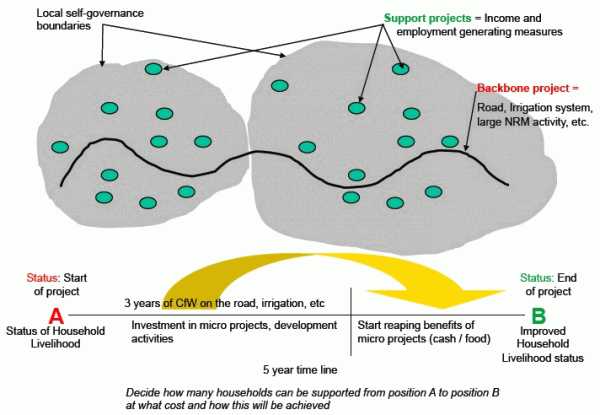
Process 9: Expansion process of backbones throughout the selected areas:
If the overall resources available for development are increased, then the number of areas that can be covered under the backbone concept can be increased. These would be covered then by respective district development funds. This would then also lead to a reduction in the area of coverage of the provincial development funds. These could be used to cover more inter-district rather than intra-district development measures. Once a backbone is completed, the communities in the area will still be eligible for support, either through one of the funds or from governmental or other donor projects and programmes. The approach is dependent upon the successful institutionalisation of the funds mentioned above.
Process 10: Capacity development in the selected districts (mostly software only):
Capacity development activities are not only undertaken in the backbone areas but also with other communities living in the district and more particularly with the emerging structures at the district level. The capacity development measures will include training in identifying problems and potential definitions, basics of village development planning, project planning, project selection, prioritising, project implementation measures, conflict sensitivity and management, good governance approaches, sustainable livelihoods, etc.
The capacity development component will also contribute to introduce numerous different methods and tools that can be utilised as part of the backbone sustainable livelihoods concept.
|
 |
Positive field evidence of impacts:
Field experience (compare experiences made in report by Paul Harvey et al in Afghanistan) indicates clearly that backbone approach using cash for work has contributed to reconstruction in what is a very challenging environment, where there are large numbers of unskilled and semi-skilled workers but where investors are reluctant to risk capital and create employment possibilities. Using cash for work to finance the backbone projects was a valid rapid response tool, and potentially an effective mechanism for triggering longer-term changes in traditional communities. Aside from the positive direct impacts on households of the cash received, the infrastructure projects carried out – roads, bridges, reforestation, wells, drinking water, school buildings and flood protection – proved to be beneficial for local livelihoods.
Furthermore, there is sufficient evidence showing that cash transfers can be successful on a large scale. Improvements to the road system in particular dramatically increased the volume of goods transported to and from local markets, accompanied by a sharp drop in transport costs. Thus, the project promoted local markets and facilitated trade in affected areas. Mortality rates in pregnancy and childbirth, as well as from serious illness, were reduced as patients could be transported from remote villages to health centres in time for treatment.
These improvements triggered some motivational and social changes. The cash for work approach persuaded labourers and villagers to maintain the small feeder roads built to connect their villages to the larger ‘backbone’ project roads, thereby possibly encouraging a sense of ownership and responsibility for road upkeep. In Northern Afghanistan more than 100,000 people benefited annually from the GTZ backbone project using cash for work approach. This shows that cash for work can be successful at scale, and for a long period (e.g. 2-3 years).
What could be disproved was the concern that cash may be misused for anti-social purposes. The money was largely spent to meet basic needs and what was most needed, namely food. Similarly, the presumption that cash could be more vulnerable to looting or misuse than food aid, and therefore that cash transfers should only be considered in secure situations, has also not been disproved. Results of field analysis in Afghanistan suggest that cash-based programming can be successful in insecure environments. Cash may also have positive side-effects for conflict prevention or mitigation; labourers that were previously combatants worked side by side with local farmers and community members for the first time, acting jointly to improve livelihoods in peace.
Women have also not been disadvantaged in any way as result of the cash transfers. Men and women in northern Afghanistan frequently make joint decisions on how to spend money most appropriately, and women often have access to their husbands’ cash deposit and participate in economic activities that fall within their responsibilities. Men were the recipients of cash in most of the activities and women’s participation was limited. In a very traditional and patriarchal culture there are clearly huge barriers to encouraging the greater participation of women in cash for work projects. The projects have been able to encourage some women to participate in the whole process. In a further move to encourage greater women participation, project proposals that promoted greater involvement or ownership by women were given a higher priority when deciding on projects to be supported by the district or provincial development fund. Despite these efforts, the ability to effectively involve women in very traditional society such as Afghanistan always prove to be a particular challenge.
Photo 2: Pay-day as part of cash for work on a backbone project
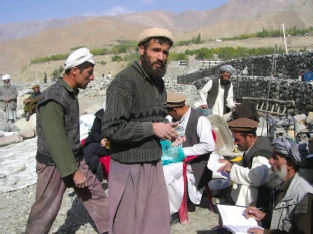
|







